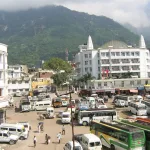World Wetlands Day is celebrated every year on 2 February to raise global awareness about the importance of wetlands for humanity and ecological well being of the planet Earth as only with healthy wetland ecosystems we can counteract climate change, water scarcity, flooding and stop the collapse of biodiversity. This day also marks the adoption of the Ramsar Convention on wetlands named after the Iranian city of Ramsar where it was officially signed on 2nd of Feb 1971. The major objective of the convention is to ensure proper conservation and wise use of all wetlands via local and national actions and international cooperation as a contribution towards achieving sustainable development throughout the world.
India is one of the contracting parties to the Ramsar Convention with the total no. Of 75 Ramsar sites (Wetlands Of International Importance). The UT of Jammu and Kashmir region has six Wetlands Of International Importance identified as Ramsar sites under the Ramsar convention viz Shallabugh, Haigam, Surinsar-Mansar, Hokersar, Wular and Tsomoriri (Ladakh). However despite Ramsar tag, the fate of these wetlands has seen no marked improvement. The famous Ramsar sites of valley like Hokersar, Wular, Haigam and Shallabugh have considerably reduced in size and are facing continuous threats mostly attributed to encroachments, dumping of solid waste and land use changes. Nearly 30 per cent of the natural wetlands in India have been lost in the last three decades mainly to illegal construction, unsustainable urbanization, agricultural expansion and pollution according to estimates by Wetlands International South Asia. This raises a query as to how helpful is Ramsar tag for wetland protection.
Wetlands are the most threatened ecosystems on planet Earth. Around 35 percent of the world’s wetlands were lost between 1970 and 2015 and the rate of decline continues to accelerate. In fact, we are losing wetlands three times faster than forests. World Wetlands Day is the ideal time to enhance people’s understanding and awareness on wetland eco-services as awareness can play a vital role in conserving and managing the wetland ecosystems all over the world. Wetlands are indispensable for the countless benefits or ecosystem services that they provide humanity. They make up only 6% of the Earth’s surface. However 40% of the world’s flora and fauna live or breed in wetlands.
Peatlands which represent half of the Earth’s wetlands are one of the Nature’s most effective carbon sinks. Despite covering just 3% of Earth’s land surface they store twice as much carbon as the world’s forests. Freshwater Wetlands are used for cultivation of paddy, for basic water needs, for fishing, harvesting of natural products like lotus stem locally known as “Nadru” in Kashmir and “Kamal Kakdi” in India, Lotus seeds (Pambach/ Kamal beej), Water chestnut (Gaer/ Singhara) etc. The Kashmir Valley is home to a chain of wetlands covering an area of more than 7,000 hectares. Most of the wetlands in kashmir region like Wular, Dal, Hokersar, Mirgund, Shallabugh and Haigam fall under Central Asian Flyway Zone (CAF) and provide a transitory habitat to lakhs of birds migrating from Siberia, Japan, and other places during their annual flyway. Besides serving as a habitat for migratory birds, Wetlands are natural defenses against disasters. Swamps form a barrier to flooding from the coast, as they intercept high tides and distribute the force of incoming water over flood plains. Keeping in view their ecosystem services, wetlands need to be conserved for future generations.
The UN Decade on Ecosystem Restoration (2021-2030) calls for the protection and revival of ecosystems around the world for the benefit of people and nature. It aims to halt the degradation of ecosystems, and restore them to achieve global goals. Therefore, the conservation of wetlands is a vital task for humanity, which can help in achieving the Sustainable Development Goals by 2030. There is a growing voice that draws the attention of the Government leading to adoption of various policies and approaches for conservation, protection, and management of wetlands. Henceforth to achieve the goal, a management strategy by undertaking following targets must be put in place to restore degraded wetlands via reduction of nutrients entering lakes, siltation control, selective deweeding, and creation of buffer zones. Also the Wetland management authorities should look into the land conversion activities going on within and around the Wetland ecosystems.
In addition to this, wetlands designated as Ramsar sites under Ramsar Convention should be strictly protected and managed under the guidelines of the convention. There is a need to adopt scientific, technical, and socio-economic cooperation to conserve the wetlands. Integrated management with a collaborative approach can pave the way for attaining the goal. World Wetlands Day 2023 is a reminder to each one of us that healthy wetlands are imperative for a healthy Earth.
(Author holds Master’s in Environmental science from Kashmir University. She teaches at Kashmir Harvard Higher Secondary Institute, Habak Naseem Bagh Srinagar and can be mailed at: [email protected])





